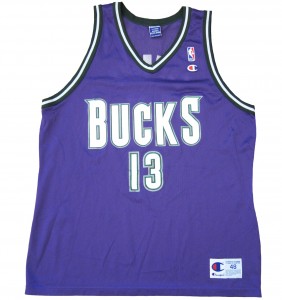In 1995, Bullets ownership looked to change the name of the team out of sensitivity to gun violence in the city. After 30+ years, the Bullets officially became the Wizards at the start of the 1997-1998 season. As a result, Champion only produced Bullets jerseys for six seasons. Therefore, there aren’t many players available compared to other teams.
One of the rarest Champion Bullets jerseys is Bernard King. King had a resurgent year with the Bullets in the 1990-1991 season, becoming an All Star despite playing on a surgically repaired knee. Therefore, Champion released King replica jersey for the 1991-1992 season. However, King wouldn’t even step on the court of the 1991-1992 season due to complications with his knee, and he would never play another game for the Bullets (in fact, he was out of basketball for a year and half and only played 32 games with the Nets in 1993 before officially retiring). So there was only one limited production run of King Bullets jerseys.

Champion issued the Bernard King jersey for the 1991-1992 season, but King would not suit up for the Bullets that year or ever again.
Most early Bullets jerseys are tough to find since they didn’t have much star power and were a mediocre team. So the jerseys were limited to a few players and production runs were small, with most sales locally in the DC market. The exception would be Calbert Cheany, who was drafted prior to the 1993-1994 season. Cheaney was a popular collegiate player at Indiana, so Champion did nationally distribute his jersey.
In 1994-1995, the Bullets would pickup Chris Webber from the Warriors and draft Juwan Howard out of Michigan. Having two members of Michigan’s Fab Five reunited on the same NBA team immediately created a huge demand for Bullets jerseys. As a result, Champion nationally distributed Webber and Howard jerseys, and those are the most abundant Bullets jerseys around. For Webber’s initial season with the Bullets in 1994-1995, he wore #2, because Scott Skiles had #4. So Webber’s #2 jersey was only produced for one season, but they aren’t hard to find because Champion printed a lot given Webber’s popularity. Champion Bullets jerseys produced from 1991-1992 through 1994-1995 have the player’s name in blue on the back with white outline.

Chris Webber joined the Bullets for the 1994-1995 season after a rookie season with the Warriors. He wore #2 for his first season with the Bullets since Scott Skiles had #4.
For the 1995-1996 season, Champion changed the players name on the back of the jersey to be white with blue outline. Scott Skiles was traded to the Orlando Magic, and as a result, Chris Webber changed to his traditional #4 jersey. That same season, the Bullets would draft Rasheed Wallace out of UNC, and Wallace’s jersey was also nationally distributed and produced in a large quantity. Champion would release white home jerseys starting in 1995-1996, but only for Chris Webber and Juwan Howard. As usual, the home jerseys were printed in very limited quantities and are extremely hard to find.

For the 1995-1996 season, Webber would get his #4 back. Champion changed the players names on the back of the jersey from blue to white.
While Webber, Howard, Wallace and Cheaney jerseys are relatively easy to find given their large production runs, the other player jerseys are quite scarce. Gheorghe Muresan is probably the most collectible Bullets jersey given his cult status as one of the few 7’7 players to every play in the NBA (and starring in the movie My Giant).









